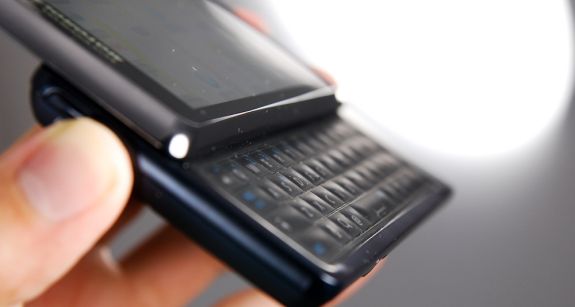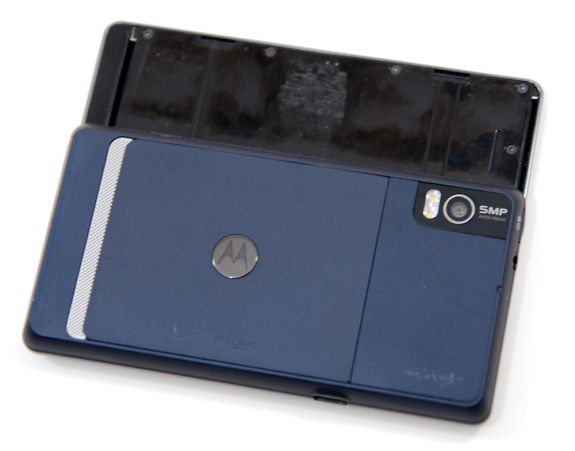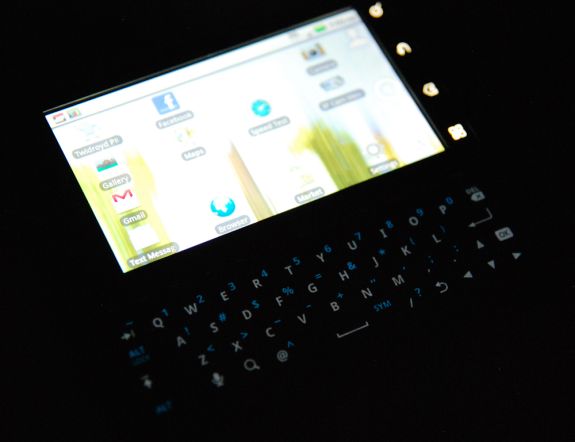Motorola Droid 2 Review: Rebooting the Droid
by Brian Klug on September 19, 2010 7:00 AM EST- Posted in
- Smartphones
- Droid
- Motorola Droid 2
- Android
- Mobile
Finally, a usable hardware keyboard
Of course, what’s really changed about the Droid 2 is the keyboard. I reviewed the original Droid a while back, and talked a lot about why I found the first Droid’s keyboard frustrating to the point of being unusable. What I was missing however was perspective on the original Droid’s refreshed keyboard, which has somewhat raised keys, and thus much better feedback.
If you’re contemplating upgrading from the original device, just how much better the Droid 2’s keyboard will feel to you is purely a function of which revision of the original Droid you’re coming from. If you were an early adopter and got the first one, the difference is dramatic to the point of earth shattering. Most people I know with the first revision, concave-key sporting version don’t even use the hardware keyboard. However, if you’ve already got a later revision from hopping onboard later or RMA, the difference isn’t nearly as dramatic.

Motorola Droid (original) Keyboard
The oversized Dpad is gone, which is good for most things as it just didn’t serve much purpose in Android, but did have get use in some game emulators and other programs. Android developers are likely going to build interaction paradigms around whatever inputs are present on a majority of devices, and there just doesn’t seem to be a majority of Android handsets with Dpads or optical trackpads. You’re not totally screwed if you needed directional controls, however, as the Droid 2 maintains up down left and right keys in the bottom right. What’s really nice about the Droid 2 keyboard is that the space picked up from ditching the DPad has been put to really good use. The keyboard is arranged in an offset pattern just like a real QWERTY keyboard should be.
The domes themselves are also convex, just like they always should have been. Even better are raised bars on j and f for index finger placement—again, just like a real keyboard.
There are dedicated search, microphone input, back, and ok buttons as well. The result is that with the exception of home, all of the capacitive buttons are present in landscape mode as well. There’s alt-lock in the place of caps lock, which is a bit odd, but everything you’d expect is here.
The keyboard slider assembly is likewise unchanged from the original Droid. There’s no spring assist—just friction. There are thankfully two clicks for keeping the phone in the closed or open position, but nothing more. Sliding the tray open and closed is smooth, but not very.
After a week of use—greasy glossy back and scrapes from sliding mechanism
I don’t think anyone will complain about it, and don’t get me wrong—it isn’t a problem—but I’m left wondering why Motorola seriously couldn’t add two strips of Teflon to the slider and make it feel smooth as glass. HTC has done it forever.
As it stands, you can clearly see the slider assembly making marks on the glossy back of the display, which begs another question: why the heck is this so glossy? Regardless, the addition of some teflon would make the Droid 2’s slider rightfully feel like a piece of precision engineering or an expensive micrometer. Otherwise, it feels forced and a bit cheap. There’s also one or two degrees of oreo effect when the keyboard tray is closed. In the open position, the mechanism is completely solid.
The Droid 2's backlighting is adequate, but just a bit understated. I didn't have problems finding keys in the dark, but they're not super bright, just lit.
On the whole, the Droid 2 feels much the same as the original device. What’s different is that Motorola has worked out the few hardware oddities (like that chin at the bottom) and smoothed over the hardware’s rough spots. Literally smoothed over—the 2 has gracefully rounded edges along the outside and slightly longer radius curves in most others.
The result is probably the most optimal balance between ties to the old Droid and a much needed refresh.














39 Comments
View All Comments
WasabiVengeance - Sunday, September 19, 2010 - link
The dpad on the original droid was a HUGE selling point for me. I got one of the later model ones with convex keys, and I've been very happy with the keyboard. My one and only complaint was that the dpad didn't have diagonals. This looks to me like they took arguably the BEST smartphone keyboard on the market, and made it significantly worse.vol7ron - Sunday, September 19, 2010 - link
But now you have arrow keys and a full QWERTY keyboard (save function and numeric keys).I actually like the new design better, perhaps you can get a dpad casing to play those games that require it.
deputc26 - Sunday, September 19, 2010 - link
Where' the battery life analysis and real-world web-page loading times? Where's the competitive comparison and commentary?Brian Klug - Sunday, September 19, 2010 - link
I completely spaced on the battery life section - I had it written and all ready, but completely forgot to insert it in the document. It's there now though! ;)-Brian
Marko_Polo - Sunday, September 19, 2010 - link
Prior to obtaining the Droid2, I was using a standard Samsung flip phone. I have been watching the Smartphone market for years mostly as a disinterested party. When I started dating a more tech savvy woman, I realized that I needed greater connectivity to my friends and family.I have had zero problems with learning how to operate and maximize the Droid 2. I chose the Droid 2 over the Droid X because I wanted a physical keyboard and a smaller size phone. Since I get a substantial Verizon discount through work, I knew I was sticking with a Verizon Smartphone (plus all my peeps are using Verizon). I also have a ZuneHD and really liked the similarity in the interfaces between the devices.
Certainly, the Droid 2 can replace many other types of devices. I have a B&N nook and I have installed the nook app on my Droid and have found it enjoyable enough to use. I also think the Droid 2 could replace my PMP in the car. However, I don't think the Droid 2 makes a great PMP overall because it is very heavy to use while exercising or doing yard work. I'm also not convinced it can handle the sweat and other moisture it would come in contact with while being active.
Finally, I have had little problem with battery life. At work, the poor thing struggles to get a 3G signal and I believe that causes the battery to drain a little quicker. I have the car dock and the multimedia dock at home, so I rarely see the battery get below 40% between charges.
For my first Smartphone, I think the Droid 2 has been great so far. Additionally, I've found the service at the Verizon store to be much better than my previous carrier - that matters to me, especially at the higher end of the Smartphone market.
Ratman6161 - Sunday, September 19, 2010 - link
I already have the later model Droid with improved keyboard and I kind of like the D-Pad though I don't use it that much. I've got Android 2.2 - rooted - and clocked at 1 GHz with SetCPU. So it sounds to me like I already have the equivalent of a D2 without the MotoBlur crap.Think I'll keep what I have for the foreseeable future!
sprockkets - Sunday, September 19, 2010 - link
"This feature is basically broken on the Droid 2. There’s just no other way to state it. If you’re getting the Droid 2 for the built in 3G hotspot feature, reconsider until Verizon and Motorola address it with an OTA update. Or use one of a number solutions from the market, or root. Either way, this was disappointing for me."Do you mean 3rd party solutions from the software market or different phones from the market? And how does rooting the phone fix the issue? Is it because you put on different firmware?
neutralizer - Sunday, September 19, 2010 - link
3rd party solutions from the market will allow you to tether. In addition, you can get free wifi tether if you're rooted. It's just an app that requires root.Brian Klug - Sunday, September 19, 2010 - link
Third party solutions I have a feeling will work fine, but the built-in default 3G hotspot functionality is completely broken. Sadly I can't root these review units quite yet, but I'm comfortable that those will work.-Brian
deputc26 - Sunday, September 19, 2010 - link
Much better, thanks!